See Digital Printed Pots
See Selected Answers to Questions from Students and Press 2012 - 2017

10 January 2020
A Guide to Clay 3D Printing
I have written this Pdf guide that is based on the workshops that I present. It covers:
Setting up a Clay 3D Printer,
3D Files for Clay Printing,
Clay for 3D Printing,
Converting a Reasonably Priced 3D Printer to Print with Clay,
Self Build Clay Printhead,
Cura for Clay 3D Printing.
Download
|
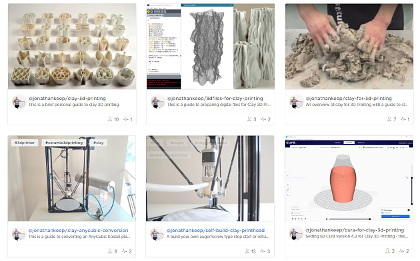
|

29 May 2020
Testing of Six Clays for Extrusion 3D Printing
I have written up the results of these test as downloadable Pdf's. This test looks at measuring clay consistency, the ratio of clay to water and clay shrinkage when bone dry, bisque fired and fired to a low stoneware temperature.
Download
|
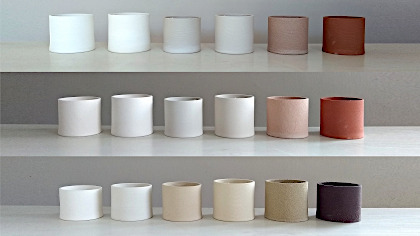
|

29 May 2020
Formulating and Testing a Clay Body for Extrusion Clay 3D Printing
This test looks at some of the considerations and the principals of formulating and testing a clay body for 3D printing. The difference of clay consistency on surface quality and print capability is observed as is the addition of additives to improve these qualities.
Download
|
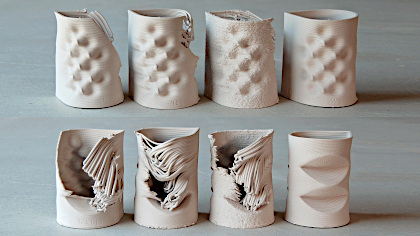
|

29 May 2020
Testing the relationship between Nozzle Size, Layer Height, Print Speed and Material Consistency for Clay Extrusion 3D Printing
Concentrating on print quality, these tests focus on three important factors when printing. First the ration between nozzle size and slice or layer height. Secondly the influence of print speed and thirdly whether using stiff or hard clay is advantages.
Download
|
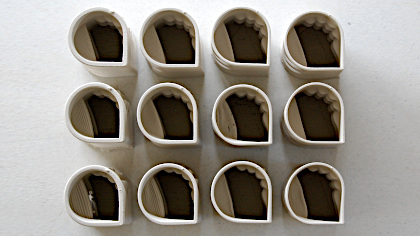
|

10 January 2020
Potting in a Digital Age
Studio Potter | Vol 47 No1 Winter/Spring 2019
As far as I am concerned an art work should reflect the age in which it is made. For good or bad we cannot avoid the influence computers are having in our society and on our lives. In this article I look at how computers and computation are being used in the pottery studio and how this could change the way we think about pots.
Download
|
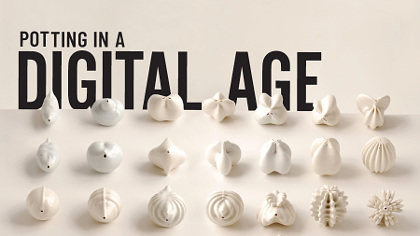
|

10 January 2020
The Fourth Way
Ceramic Review | Issue 240 Nov/Dec 2014
In this article I write about how I became interested in and why I use computers in my work. Written five years ago I feel it has stood the test of time well. I also suggest that 3D printing offers a fourth way to giving form to clay – the original three being handbuilding, wheel throwing and moulding.
Download
|
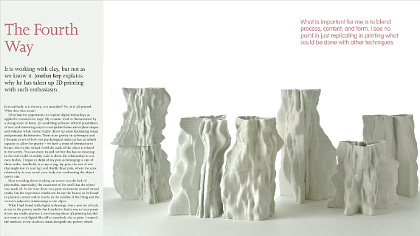
|

19 - 20 / 26 - 27 November 2018
SHORT COURSE – RCA, LONDON
There is always a good uptake of this course that I do in the Ceramic and Glass department at the RCA but not many students gone on to incorporate this way of working into their studio practice. The equipment is available to students and staff across the whole art school and so the printers are still well used and the technical staff are kept busy supporting projects from outside of the department.This trend is not uncommon, where I have found more interest for ceramic 3D printing coming from creative practitioners who would not consider themselves clay specialists. I fully understand the situation as most people specialising in ceramics do because they like making things with their hands. However I still believe that it is important that the use of computer aided technology is introduced to clay specialist students in their education so they are aware of what tool sets are available – for conceptually and technical reasons.We had a visit from Prince Charles during the course. Pictured with the Prince is Nico Conti, a second year student who has continued to explore 3D printing and the use of custom nozzles and chaotic structures. |
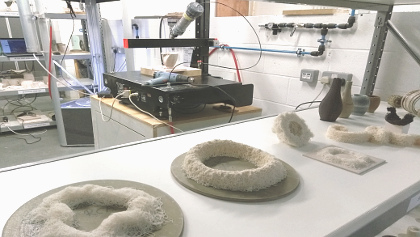
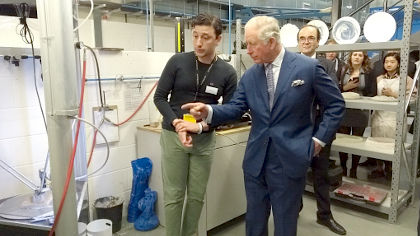
|

13 -17 November 2018
COMPUTATION CLAY - ARTLAB ACCADEMIA SIRONI, SARDINIA
Computation Clay - new ways to work clay in art and design. This was the description for the workshops that I presented for The Academy of Fine Arts,‘Mario Sironi based in Sassari Sardinia. The Accademia Sironi has established an Art Lab at Mas.Edu museum in Sassari to serve students and the local creative community.
The workshops were open to students, makers, architects, master ceramicists, artisans and companies concerned with the artistic fields. The laboratory is well equipped with a Delta WASP 20/40 clay/plastic printer, Formlabs Form 2 printer with ceramic resin, Delta WASP 60/100 for pla/abs as well as other kit common to FabLabs such as laser cutters and thermoforming machines. The lab is very well organised and run by Pier Paolo Luvoni who himself makes fine printed ceramics.
|
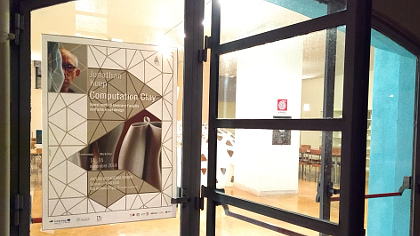
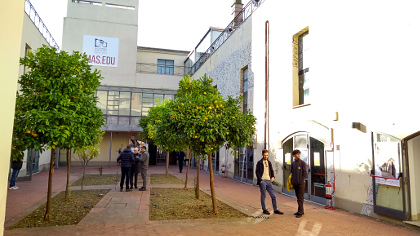
|

16 September - 13 October 2018
KERAMIK SYMPOSIUM GMUNDEN, AUSTRIA
For four weeks, from mid September into October I joined nine other ceramic artists in Austria for the Gmunden Ceramic Symposium residency.
Celebrating 55 years since the first Symposium, founded by Kurt Ohnsorg, the Laufen sanitaryware factory rejoined tableware producers Gmunden Ceramics to offer studio facilities for the resident artists. Laufen, with a well developed model making CAD department were anxious to host artists using digital tools and I guess that is why I got the invitation.
This is the first time I have had the opportunity to work in a ceramic factory and the experience was fascinating. The scale of production is extraordinary and while the processes and materials are all so familiar from the pottery studio a factory takes it to another level. What was interesting in Laufen was although much is automated there was still that sense of skill in process and material knowledge.
As a successful Europe based ceramic production company you can see how they have needed to work at every element of the business to stay ahead of overseas competition. Design led, the CAD department enables them to develop and change designs very quickly within the production. Production combines automation and high manual skill to maintain quality, while material development in the form of their special SaphirKeramik clay body enables them to produce thin but robust shapes. Design, material and process are all important to this innovative company.
The Italian 3D printer company WASP sent one of their recently launched DELTA40100 clay printers for me to use during the residence. Using the Laufen SaphirKeramik clay, that was not ideal for 3d printing as being designed for slip casting it lacks plasticity, the WASP printer was just brilliant. The residency was a chance to work on a large scale having a printer that can print 40 cm wide and 1 meter high, and then the kilns to fire work of that size. Unfortunately there was just not the time to make full use of these opportunities.
Working on a new series of work based around fractal patterns there was just too much going on and large scale 3D clay printing needs time. The Symposium culminated in an exhibition that is currently on in the K-Hof Kammerhof Museums in Gmunden and runs until 4 Nov 2018, and then will tour. |
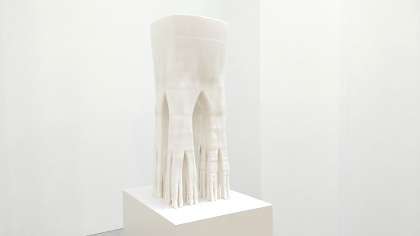
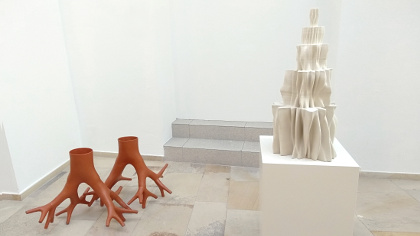
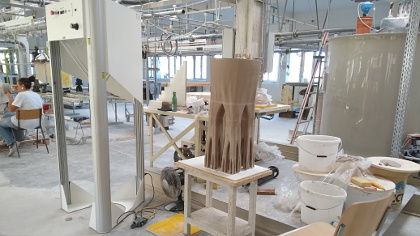
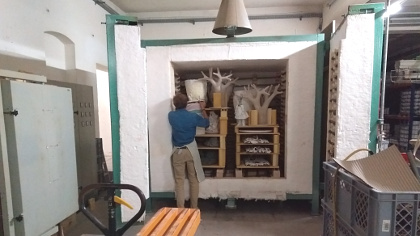
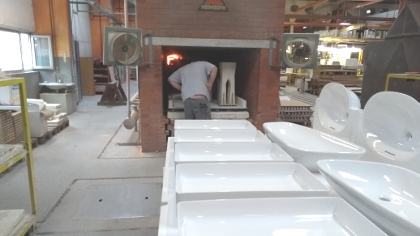
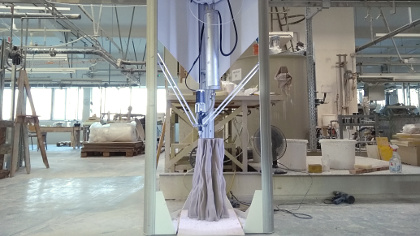
|

7 – 10 September 2018
EXHIBIT60 - THE PRINTROOM, SUFFOLK
This exhibition was a chance to look back over a selection of my work from the last twenty years. This period of time more or less covers the period where computers have come to influence how I think about my work and how I make my work.
Sixty works comprising both digital drawings and pots, digital and analogue made up the exhibition. Older large pots were exhibited outside while Monica Petzal’s beautiful, spacious Printroom studio was ideal for displaying the framed drawings alongside the pots. I would like to thank everybody who so generously supported this all too brief exhibition. |
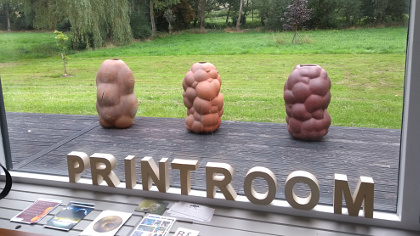
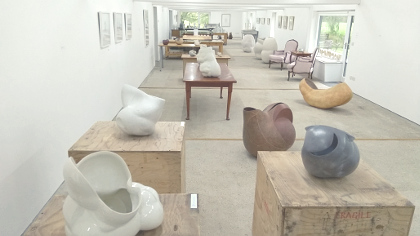
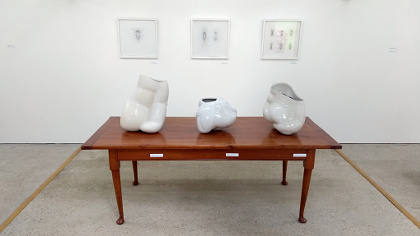
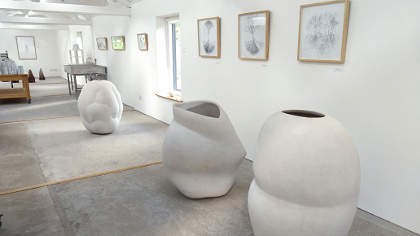
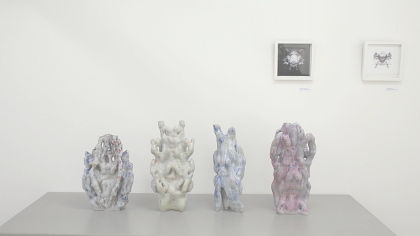
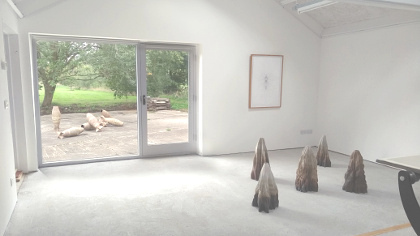
|

05 September 2018
BEYOND PATTERN & CHAOS SYMPOSIUM, NORWICH UNIVERSITY OF THE ARTS
This one day symposium was organised by the NUA interdisciplinary research group dedicated to the practice and theory of pattern, chaos and the spaces in between. Invited to talk about how I use computer code in my work this was a fascinating day. Presentations and conversations through the day ranged from the real to the imaginary, from science to art, from the messy to the ordered. Question like 'do we find comfort in pattern and intrigue in chaos' and observations like 'detail has pattern, the bigger picture is chaos' or the concept of collecting vs the non-normative apparent disorder of hoarding made for a most thought provoking day. |
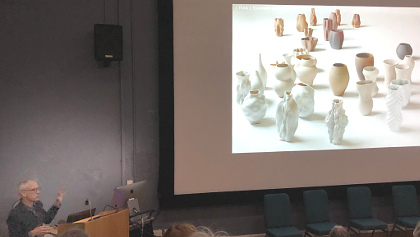
|

28 – 31 August 2018
WASP, ITALY - RAISE THE BAR FOR CLAY 3D PRINTING
In August I again visited WASP, the Italian 3D printer manufacturer and wonderfully maverick collective who are out to save the world with technology – eco friendly technology. The visit was because together we did a couple of workshops at MIC (Museum of International Ceramics) in Faenza as a prelude to partaking in the Argilla Ceramic Festival 2018.
WASP has recently launched their clay Delta 40100 (40 cm wide, 100cm build dimensions) and I challenge any other 3D printer to be as robust, precise, while working at speed with such a volume of clay. I have now been working with this machine for some time and it has just been a pleasure. I’ve made from small cups to large sculptural forms with it and it has not skipped a beat. My one comment would be that it is a pity that the build width is not 60 cm but I appreciate that if it was the machine would not fit through a standard door and not be as portable as it is.
During my stay at the WASP factory in Massa Lombarda I was able see their experiments in high speed and continues clay feed printing using the Delt40100 linked to a pugmill. This was very impressive. I was also fortunate to be there at the right time to see the ‘crane’ 3D printer building the clay house, ‘Gaia’ that was the central feature of Shamballa, a festival and conference on large-scale 3D printing and green building held earlier in October.
Congratulations to WASP for taking clay 3D printing to another level. |
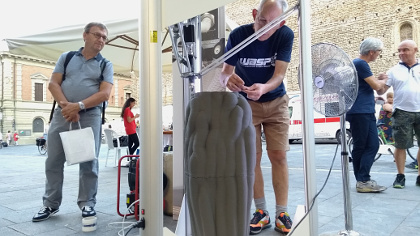
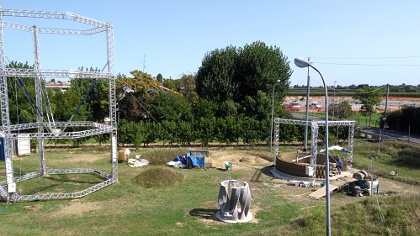
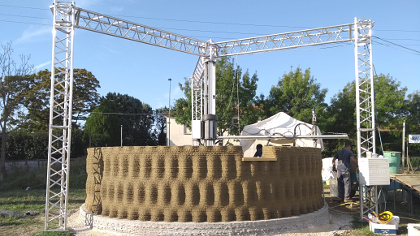
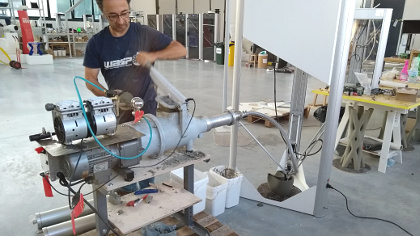
|

08 – 18 August 2018
ESTONIAN ACADEMY OF ARTS CLAY 3D PRINTING SUMMER SCHOOL, TALLINN
Held in the ceramics department at the Estonian Academy of Arts in Tallinn, ten participants from 8 institutions representing 10 nationality took part in this week long intensive workshop exploring clay 3D printing. Selected from an open application participants came from architecture, design, the fine and applied arts.
Most were postgraduate students. A fluency in working digitally was a necessity and all had 3D printing experience, mostly in clay with a number of individuals having made their own clay printers. The organising body consisted of the Professor of ceramics at the Academy Urmas Puhkan, myself, Lauri Kilusk who works in the department and with clay 3D printing himself, Kaiko Kivi who operated the robot arm, Madis Kaasik who built many of the machines and Kersti Laanmaa who teaches in the ceramics department was project coordinator.
On the first day, after introductions and a short presentation by all involved we quickly ran through what equipment was available. This included one Universal Robot Arm, one large format shallow depth Cartesian flat bed type clay printer (Madis Kaasik design), one small and one medium size Madis Kaasik design Delta clay printer and one WASP 2040 printer. Participants then got on with making a start at printing projects that they had pre-prepared so that by the end of day one we had some understanding of the capabilities of the equipment and where individual’s interests lay.
Day two I gave a presentation of how I work and then so as to ensure dialogue between participants they were grouped around themes of interest and asked to develop new work. The grouping took into account personal directions and interests so one group was quite lose allowing for individuals to get on with personal projects while having a close exchange of ideas within the group. For practical reasons those wanting to make larger works that would dominate time on machines were required to work together on collaborative projects.
Days three and four where nonstop printing. The group worked really well together and with a lot of experience it was a rich working atmosphere with a great exchange of knowledge both technically and conceptually, that was always the objective of the event. Participants shared a self catering accommodation and while I am sure this was intense the exchange of ideas continued with laptops spread across the dining room table and computer work going late into the night.
The final day consisted of, in the morning discussions around technical issues of clay printing and what I consider the most interesting aspect of all this and that is the new ways of working and new ideas that computation offers to working in ceramics. I demonstrated how I use code to generate work and we touched on the theme of ‘copy, cut and paste’. The afternoon and week concluded with a pop-up exhibition of the objects created during the summer school. Where time had permitted work had been bisque fired but the exhibition was very much a work in progress and a chance to assess what were often rough and ready sketches yet to be worked up into finished works. |
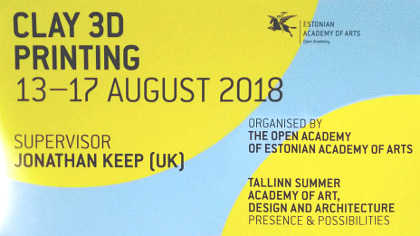
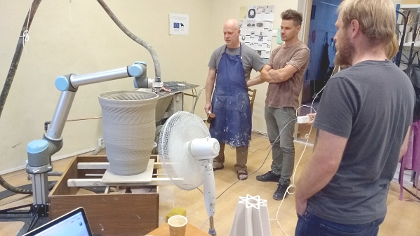
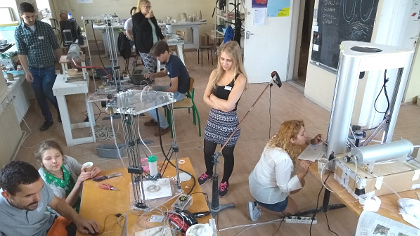
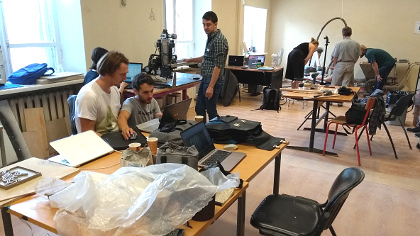
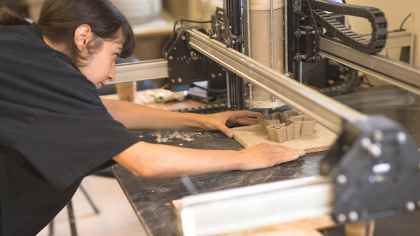
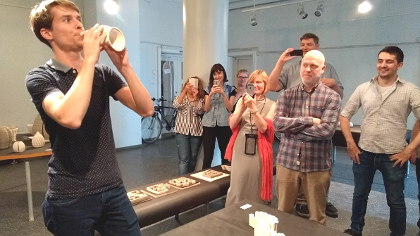
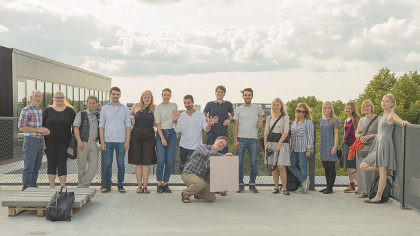
|

OLDER POSTS |